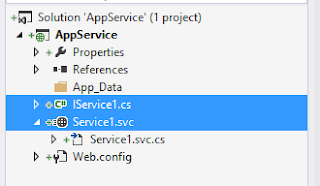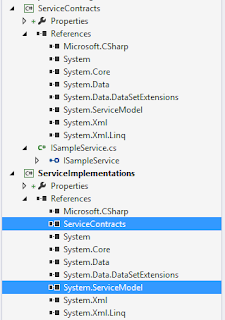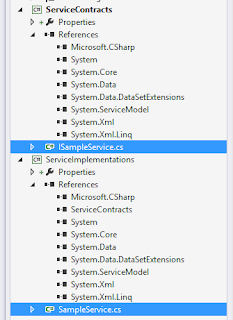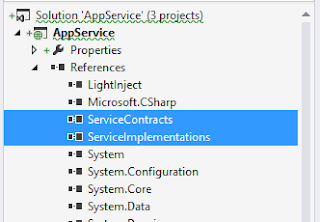This has 12 steps, let's begin
1. To continue, let's add a DTO project using Class Library project, name it Dtos. Delete Class1.cs
Add reference to System.Runtime.Serialization assembly
Add a DTO class, name it PersonDto.Member.cs. Static classes enforce schema-like organization of domain models / DTOs
using System.Runtime.Serialization;
namespace Dtos
{
public static partial class PersonDto
{
[DataContract]
public class Member
{
[DataMember]
public int MemberId { get; set; }
[DataMember]
public string MemberName { get; set; }
}
}
}
2. On ServiceContracts project, add reference to Dtos project
Then add PersonContract.IMemberService.cs interface:
using Dtos;
using System.Collections.Generic;
using System.ServiceModel;
namespace ServiceContracts
{
public static partial class PersonContract
{
[ServiceContract]
public interface IMemberService
{
[OperationContract]
string GetMembership();
[OperationContract]
IEnumerable<PersonDto.Member> GetMembers();
}
}
}
3. On ServiceImplementations project, add reference to Dtos project
Then add implementation for PersonContract.IMemberService interface, name it PersonImplementation.MemberService.cs, use the following code:
using System.Collections.Generic;
namespace ServiceImplementations
{
public static partial class PersonImplementation
{
[System.ServiceModel.ServiceBehavior(InstanceContextMode = System.ServiceModel.InstanceContextMode.PerCall)]
public class MemberService : ServiceContracts.PersonContract.IMemberService
{
IEnumerable<Dtos.PersonDto.Member> ServiceContracts.PersonContract.IMemberService.GetMembers()
{
yield return new Dtos.PersonDto.Member { MemberId = 1, MemberName = "John" };
yield return new Dtos.PersonDto.Member { MemberId = 2, MemberName = "Paul" };
yield return new Dtos.PersonDto.Member { MemberId = 3, MemberName = "George" };
yield return new Dtos.PersonDto.Member { MemberId = 4, MemberName = "Ringo" };
}
string ServiceContracts.PersonContract.IMemberService.GetMembership()
{
return "Avengers";
}
}
}
}
4. On AppService, open ServiceHostingEnvironment.tt, then save it even there's no changes on its code. Saving the text template will trigger the regeneration of the ServiceHostingEnvironment.config. The updated ServiceHostingEnvironment.config shall look like this:
<serviceHostingEnvironment aspNetCompatibilityEnabled="true" multipleSiteBindingsEnabled="true">
<serviceActivations>
<add relativeAddress="PersonImplementation.MemberService.svc" service="ServiceImplementations.PersonImplementation+MemberService" factory="AppService.LightInjectServiceHostFactory"/>
<add relativeAddress="SampleService.svc" service="ServiceImplementations.SampleService" factory="AppService.LightInjectServiceHostFactory"/>
</serviceActivations>
</serviceHostingEnvironment>
5. Run AppService
To test, run WcfTestCLient, path is: "C:\Program Files (x86)\Microsoft Visual Studio 12.0\Common7\IDE\WcfTestClient.exe"
Add Service on My Service Projects, then use this endpoint address: http://localhost:50549/PersonImplementation.MemberService.svc
Invoke GetMembers(), you shall see this output:
6. On NHibernate integration, step 0, run this DDL script:
/*
drop table Person.Member;
drop schema Person;
*/
create schema Person;
go
create table Person.Member
(
MemberId int not null identity(1,1),
MemberName nvarchar(100) not null,
constraint pk_Person_Member primary key(MemberId)
);
go
insert into Person.Member(MemberName) values
('Ironman'),
('Captain America'),
('Thor'),
('Hulk');
go
7. NHibernate's Linq is using extension method, and as such is virtually impossible to mock properly. With that said, we need to add a thin layer for accessing NHibernate, which can be mocked if we need to unit test the rich domain model's behavior
For that thin layer, create a class library project, name it UnitTestFriendlyDal
Add NHibernate from NuGet Packages
Create a class file, name it DomainAccess.cs. Then use this code on DomainAccess.cs:
using System;
using System.Linq;
using NHibernate.Linq;
namespace UnitTestFriendlyDal
{
public interface IDomainAccessFactory
{
IDomainAccess OpenDomainAccess();
}
public class DomainAccessFactory : IDomainAccessFactory
{
NHibernate.ISessionFactory _sessionFactory;
public DomainAccessFactory(NHibernate.ISessionFactory sessionFactory)
{
_sessionFactory = sessionFactory;
}
public IDomainAccess OpenDomainAccess()
{
return new DomainAccess(_sessionFactory);
}
}
public interface IDomainAccess : IDisposable
{
IQueryable<T> Query<T>();
T Get<T>(object id);
T Load<T>(object id);
object Save(object transientObject);
void Evict<T>(object id);
}
class DomainAccess : IDomainAccess
{
NHibernate.ISessionFactory _sessionFactory;
NHibernate.ISession _session;
NHibernate.ITransaction _transaction;
public DomainAccess(NHibernate.ISessionFactory sessionFactory)
{
_sessionFactory = sessionFactory;
_session = _sessionFactory.OpenSession();
_transaction = _session.BeginTransaction();
}
IQueryable<T> IDomainAccess.Query<T>()
{
return _session.Query<T>();
}
T IDomainAccess.Get<T>(object id)
{
return _session.Get<T>(id);
}
T IDomainAccess.Load<T>(object id)
{
return _session.Load<T>(id);
}
void IDomainAccess.Evict<T>(object id)
{
_sessionFactory.Evict(typeof(T), id);
}
object IDomainAccess.Save(object transientObject)
{
return _session.Save(transientObject);
}
// Because transaction is a cross-cutting concern. It should be automated
void IDisposable.Dispose()
{
// http://www.hibernatingrhinos.com/products/nhprof/learn/alert/donotuseimplicittransactions
_transaction.Commit();
_transaction.Dispose();
_session.Dispose();
}
}//DomainAccess
public static class LinqExtensionMethods
{
public static IQueryable<T> GetPage<T>(this IQueryable<T> query, int pageLimit, int pageNumber)
{
var paged = query.Take(pageLimit).Skip(pageLimit * (pageNumber - 1));
return paged;
}
}
/// <summary>
/// cross-cutting concern
/// MakeCacheable replaces Cacheable, so IQueryable detection provider can be done here
/// Can't use NHibernate's built-in .Cacheable on non-NHibernate IQueryable, it will throw an error
/// </summary>
public static class NHibernateLinqExtensionMethods
{
public static IQueryable<T> MakeCacheable<T>(this IQueryable<T> query)
{
if (query.Provider.GetType() == typeof(NHibernate.Linq.DefaultQueryProvider))
query = query.Cacheable();
return query;
}
}
}
8. Create a Class Library project. Name it RichDomainModels. Then delete Class1.cs
Then add reference to Dtos and UnitTestFriendlyDal
Add Virtuosity.Fody to the project, this AOP component saves us the need of adding virtual to every members of the domain model. All members of the domain models are required to be virtual by Nhibernate. With Virtuosity.Fody, all members are automagically made virtual for us, so we don't have to type virtual on each members anymore
Add a class file, name it PersonDomain.Member.cs, then use the folllowing code. Notice that we don't add virtual to Member's MemberId and MemberName, that's courtesy of Virtuosity.Fody
As for using static partial class (see PersonDomain on following code) instead of using namespace, we use static class to enforce schema-like way to group related domain models, namespace could be bypassed. Think of AdventureWorks database grouping related tables into their own schema
using Dtos;
using UnitTestFriendlyDal;
using System.Linq;
using System.Collections.Generic;
namespace RichDomainModels
{
public static partial class PersonDomain
{
public class Member
{
public int MemberId { get; set; }
public string MemberName { get; set; }
public static IEnumerable<PersonDto.Member> GetMembers(IDomainAccess da)
{
var list = da.Query<PersonDomain.Member>().MakeCacheable().ToList()
.Select(x =>
new PersonDto.Member
{
MemberId = x.MemberId,
MemberName = x.MemberName
});
return list;
}
}
}
}
9. Add a Class Library project, name it RichDomainModelsMapping. Then delete Class1.cs
Add NHibernate and NHibernate.Caches.SysCache to the project:
Add reference to RichDomainModels
Add a class file, name it Mapper.cs, then use the following code:
using NHibernate.Cfg; // .DatabaseIntegration extension method
using System.Linq;
namespace RichDomainModelsMapping
{
public static class Mapper
{
static NHibernate.ISessionFactory _sessionFactory = Mapper.BuildSessionFactory();
// call this on production
public static NHibernate.ISessionFactory SessionFactory
{
get { return _sessionFactory; }
}
public static NHibernate.ISessionFactory BuildSessionFactory(bool useUnitTest = false)
{
var mapper = new NHibernate.Mapping.ByCode.ConventionModelMapper();
mapper.IsEntity((t, declared) => t.Namespace == "RichDomainModels");
mapper.BeforeMapClass += mapper_BeforeMapClass;
mapper.BeforeMapProperty += mapper_BeforeMapProperty;
mapper.BeforeMapManyToOne += mapper_BeforeMapManyToOne;
mapper.BeforeMapBag += mapper_BeforeMapBag;
var cfg = new NHibernate.Cfg.Configuration();
// .DatabaseIntegration! Y U EXTENSION METHOD?!
cfg.DataBaseIntegration(c =>
{
// SQL Server
c.Driver<NHibernate.Driver.SqlClientDriver>();
c.Dialect<NHibernate.Dialect.MsSql2008Dialect>();
c.ConnectionString = "Server=.;Database=PlayTheWcfServiceApp;Trusted_Connection=True";
if (useUnitTest)
{
c.LogSqlInConsole = true;
c.LogFormattedSql = true;
}
});
System.Collections.Generic.IEnumerable<System.Type> entities =
typeof(RichDomainModels.PersonDomain.Member).Assembly.GetExportedTypes()
// exclude static classes (the schema name)
// this will still include the non-static class inside of static classes, i.e., the domain models
.Where(x => !(x.IsAbstract && x.IsSealed));
NHibernate.Cfg.MappingSchema.HbmMapping mapping = mapper.CompileMappingFor(entities);
cfg.AddMapping(mapping);
cfg.Cache(x =>
{
// SysCache is not stable on unit testing
if (!useUnitTest)
{
x.Provider<NHibernate.Caches.SysCache.SysCacheProvider>();
// I don't know why SysCacheProvider is not stable on simultaneous unit testing,
// might be SysCacheProvider is just giving one session factory, so simultaneous test see each other caches
// This solution doesn't work: http://stackoverflow.com/questions/700043/mstest-executing-all-my-tests-simultaneously-breaks-tests-what-to-do
}
else
{
// This is more stable in unit testing
x.Provider<NHibernate.Cache.HashtableCacheProvider>();
}
// http://stackoverflow.com/questions/2365234/how-does-query-caching-improves-performance-in-nhibernate
// Need to be explicitly turned on so the .Cacheable directive on Linq will work:
x.UseQueryCache = true;
});
#if DEBUG
if (useUnitTest)
cfg.SetInterceptor(new NHSQLInterceptor());
#endif
//new NHibernate.Tool.hbm2ddl.SchemaUpdate(cfg).Execute(useStdOut: false, doUpdate: true);
//using (var file = new System.IO.FileStream(@"c:\x\ddl.txt",
// System.IO.FileMode.Create,
// System.IO.FileAccess.ReadWrite))
//using (var sw = new System.IO.StreamWriter(file))
//{
// new SchemaUpdate(cfg)
// .Execute(sw.Write, false);
//}
NHibernate.ISessionFactory sf = cfg.BuildSessionFactory();
return sf;
}
#if DEBUG
class NHSQLInterceptor : NHibernate.EmptyInterceptor
{
// http://stackoverflow.com/questions/2134565/how-to-configure-fluent-nhibernate-to-output-queries-to-trace-or-debug-instead-o
public override NHibernate.SqlCommand.SqlString OnPrepareStatement(NHibernate.SqlCommand.SqlString sql)
{
Mapper.NHibernateSQL = sql.ToString();
return sql;
}
}
public static string NHibernateSQL { get; set; }
#endif
static void mapper_BeforeMapBag(
NHibernate.Mapping.ByCode.IModelInspector modelInspector,
NHibernate.Mapping.ByCode.PropertyPath member,
NHibernate.Mapping.ByCode.IBagPropertiesMapper propertyCustomizer)
{
propertyCustomizer.Cache(cacheMapping => cacheMapping.Usage(NHibernate.Mapping.ByCode.CacheUsage.ReadWrite));
propertyCustomizer.Lazy(NHibernate.Mapping.ByCode.CollectionLazy.Extra);
/*
* class Person
* {
* IList<Hobby> Hobbies
* }
*
*
*/
string parentEntity = member.LocalMember.DeclaringType.Name; // this gets the Person
string foreignKey = parentEntity + "Id";
propertyCustomizer.Key(keyMapping => keyMapping.Column(foreignKey));
// http://www.ienablemuch.com/2014/10/inverse-cascade-variations-on-nhibernate.html
// best persistence approach: Inverse+CascadeAll
propertyCustomizer.Inverse(true);
propertyCustomizer.Cascade(NHibernate.Mapping.ByCode.Cascade.All);
}
static void mapper_BeforeMapManyToOne(
NHibernate.Mapping.ByCode.IModelInspector modelInspector,
NHibernate.Mapping.ByCode.PropertyPath member,
NHibernate.Mapping.ByCode.IManyToOneMapper propertyCustomizer)
{
/*
public class Product
{
protected internal int ProductId { get; set; }
public ProductionDomain.ProductCategory ProductCategory { get; protected internal set; }
public string ProductName { get; protected internal set; }
}
*/
// ProductCategory property name maps to ProductCategoryId column name
propertyCustomizer.Column(member.ToColumnName() + "Id");
}
static void mapper_BeforeMapProperty(
NHibernate.Mapping.ByCode.IModelInspector modelInspector,
NHibernate.Mapping.ByCode.PropertyPath member,
NHibernate.Mapping.ByCode.IPropertyMapper propertyCustomizer)
{
//string postgresFriendlyName = member.ToColumnName().ToLowercaseNamingConvention();
//propertyCustomizer.Column(postgresFriendlyName);
}
static void mapper_BeforeMapClass(NHibernate.Mapping.ByCode.IModelInspector modelInspector,
System.Type type,
NHibernate.Mapping.ByCode.IClassAttributesMapper classCustomizer)
{
classCustomizer.Cache(cacheMapping => cacheMapping.Usage(NHibernate.Mapping.ByCode.CacheUsage.ReadWrite));
string fullName = type.FullName; // example: RichDomainModels.ProductionDomain+Product
string[] fullnameSplit = fullName.Split('+');
string schemaName;
string className;
if (fullnameSplit.Length == 2) // The domain model is in a schema (e.g., ProductionDomain)
{
schemaName = fullnameSplit[0].Split('.').Last();
schemaName = schemaName.Substring(0, schemaName.Length - "Domain".Length); // removes the suffix Domain
className = fullnameSplit[1];
}
else // domain model is not inside schema
{
schemaName = "dbo";
className = fullnameSplit[0].Split('.').Last();
}
// Last() skips the other namespace(s). 3 skips the word The
string tableFullname = schemaName + "." + className;
classCustomizer.Table(tableFullname);
System.Reflection.MemberInfo mi;
System.Reflection.MemberInfo[] memberInfos = type.GetMember(className + "Id",
System.Reflection.BindingFlags.Public | System.Reflection.BindingFlags.NonPublic | System.Reflection.BindingFlags.Instance);
if (memberInfos.Length == 1)
{
mi = memberInfos[0];
}
else
{
System.Reflection.MemberInfo[] defaultIdNames = type.GetMember("Id",
System.Reflection.BindingFlags.Public | System.Reflection.BindingFlags.NonPublic | System.Reflection.BindingFlags.Instance);
if (defaultIdNames.Length == 0)
throw new System.Exception("Impossible. Should have an ID");
else if (defaultIdNames.Length == 1)
mi = defaultIdNames[0];
else
throw new System.Exception("Houston we have a problem. Why there's multiple ID property?");
}
classCustomizer.Id(mi,
idMapper =>
{
idMapper.Column(mi.Name);
idMapper.Generator(NHibernate.Mapping.ByCode.Generators.Identity);
});
}
} // Mapper
}
10. On AppService
Add NHibernate to the project, and add reference to RichDomainModelsMapping and UnitTestFriendlyDal
On Global.asax.cs, add the wiring of NHibernate ISessionFactory and Domain Access Layer, line 38 and 39:
using System;
using System.Linq;
using UnitTestFriendlyDal;
namespace AppService
{
public class Global : System.Web.HttpApplication
{
protected void Application_Start(object sender, EventArgs e)
{
DependencyFactory.Container = new LightInject.ServiceContainer();
RegisterIocs();
}
static void RegisterIocs()
{
//// Instead of manually adding each implementation:
//DependencyFactory.Container.Register<ServiceImplementations.ProductImplementation.ProductService>(new LightInject.PerRequestLifeTime());
//DependencyFactory.Container.Register<ServiceImplementations.PersonImplementation.MemberService>(new LightInject.PerRequestLifeTime());
// Just do this:
var serviceImplementations = typeof(ServiceImplementations.SampleService).Assembly.GetTypes()
.Where(t => t.GetInterfaces()
.Any(i => i.GetCustomAttributes(false)
.Any(a => a.GetType() == typeof(System.ServiceModel.ServiceContractAttribute))));
foreach (var item in serviceImplementations)
{
DependencyFactory.Container.Register(item, new LightInject.PerRequestLifeTime());
}
DependencyFactory.Container.Register<IDomainAccessFactory, DomainAccessFactory>(new LightInject.PerContainerLifetime());
DependencyFactory.Container.RegisterInstance<NHibernate.ISessionFactory>(RichDomainModelsMapping.Mapper.SessionFactory);
}
}
}
11. On ServiceImplementations, add reference to UnitTestFriendlyDal and RichDomainModels
Then change the PersonImplementation.MemberService to this code:
using System.Collections.Generic;
using UnitTestFriendlyDal;
namespace ServiceImplementations
{
public static partial class PersonImplementation
{
[System.ServiceModel.ServiceBehavior(InstanceContextMode = System.ServiceModel.InstanceContextMode.PerCall)]
public class MemberService : ServiceContracts.PersonContract.IMemberService
{
IDomainAccessFactory _daf;
public MemberService(IDomainAccessFactory daf)
{
_daf = daf;
}
IEnumerable<Dtos.PersonDto.Member> ServiceContracts.PersonContract.IMemberService.GetMembers()
{
using (var da = _daf.OpenDomainAccess())
{
return RichDomainModels.PersonDomain.Member.GetMembers(da);
}
}
string ServiceContracts.PersonContract.IMemberService.GetMembership()
{
return "Avengers";
}
}
}
}
12. Make sure the connection string is correct on RichDomainModelsMapping
Run AppService
To test, run WcfTestClient and click Invoke on GetMembers, you shall see the following:
Complete code at: https://github.com/MichaelBuen/PlayWcfServiceApplication
Happy Coding!


















